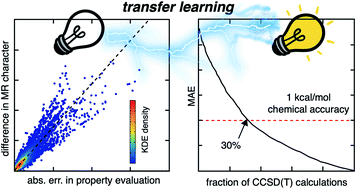Detection of multi-reference character imbalances enables a transfer learning approach for virtual high throughput screening with coupled cluster accuracy at DFT cost†
Abstract
Appropriately identifying and treating molecules and materials with significant multi-reference (MR) character is crucial for achieving high data fidelity in virtual high-throughput screening (VHTS). Despite development of numerous MR diagnostics, the extent to which a single value of such a diagnostic indicates the MR effect on a chemical property prediction is not well established. We evaluate MR diagnostics for over 10 000 transition-metal complexes (TMCs) and compare to those for organic molecules. We observe that only some MR diagnostics are transferable from one chemical space to another. By studying the influence of MR character on chemical properties (i.e., MR effect) that involve multiple potential energy surfaces (i.e., adiabatic spin splitting, ΔEH–L, and ionization potential, IP), we show that differences in MR character are more important than the cumulative degree of MR character in predicting the magnitude of an MR effect. Motivated by this observation, we build transfer learning models to predict CCSD(T)-level adiabatic ΔEH–L and IP from lower levels of theory. By combining these models with uncertainty quantification and multi-level modeling, we introduce a multi-pronged strategy that accelerates data acquisition by at least a factor of three while achieving coupled cluster accuracy (i.e., to within 1 kcal mol−1 MAE) for robust VHTS.

- This article is part of the themed collection: Editor’s Choice: Malika Jeffries-EL


 Please wait while we load your content...
Please wait while we load your content...